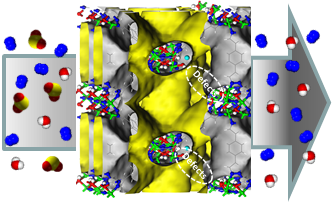Metal-organic framework based materials for capture and degradation of toxic molecules
Link (Zoom): https://nanoscience-imdea.zoom.us/j/97310651781
Abstract:
Metal organic frameworks have blossomed as an amazing class of easily engineered crystalline porous materials with properties overcoming those of classical adsorbents and catalysts.1 Metal organic frameworks (MOFs) are amenable to fine tuning their pore size, polarity, framework flexibility and functionality by the adequate choice of metal fragments and organic linkers thereby determining the adsorbate diffusivity, adsorption energy and reactivity in the pore structure. Moreover, the wise introduction of functional groups, the deliberate creation of defects and the formation of composites can be used to further improve the properties of these materials.2,3 The ultimate goal of these strategies is to bring these materials into practical applications.

In this lecture, I will give a critical overview of some topics that have been addressed in our research group and the knowhow that we have achieved. A special focus will be devoted to the study of the impact of pore size and polarity modulation, introduction of defects and formation of composites on the capture and degradation of toxic gases and vapours.4,5
Figure 1. Schematic representation of the impact of creation of defects on the selective capture of SO2.3
[1] O. M. Yaghi, M. J. Kalmutzki, C. S. Diercks Introduction to Reticular Chemistry: Metal-Organic Frameworks and Covalent Organic Frameworks, Wiley-VCH, Weinheim, 2019. 509 pp.
[2] L. M. Rodríguez-Albelo, et al, Selective sulfur dioxide adsorption on crystal defect sites on an isoreticula. Metal Organic Framework series, Nature Commun. 2017, 8, 14457.
[3] M Fandzloch, CR Maldonado, J. A. R. Navarro, E Barea Biomimetic 1-Aminocyclopropane-1-Carboxylic Acid Oxidase Ethylene Production by MIL-100(Fe)-Based Materials, ACS Applied Mater. Interf. 2019, 11, 34053-34058.
[4] R Gil-San-Millan, et al, Magnesium Exchanged Zirconium Metal–Organic Frameworks with Improved Detoxification Properties of Nerve Agents, J. Am. Chem. Soc., 2019, 141, 11801-11805.
[5] J. Castells-Gil, et al. Heterometallic Titanium-Organic Frameworks as Dual Metal Catalysts for Synergistic Non-Buffered Hydrolysis of Nerve Agent Simulants, Chem, 2020, 6, 1–14.




